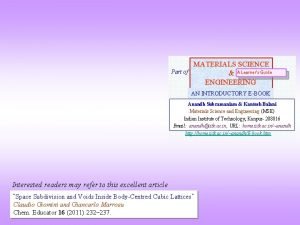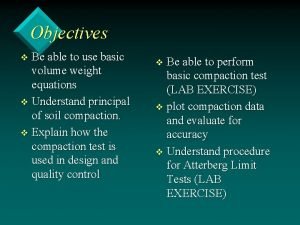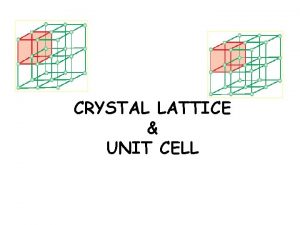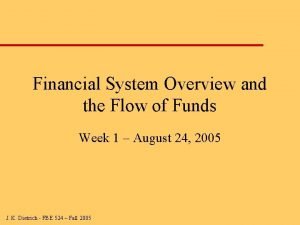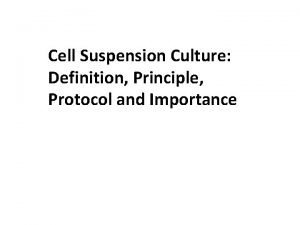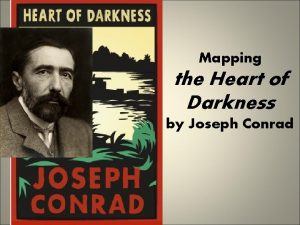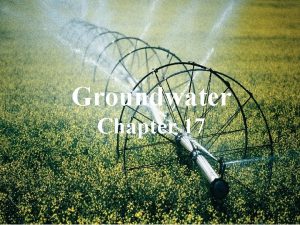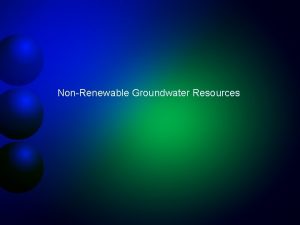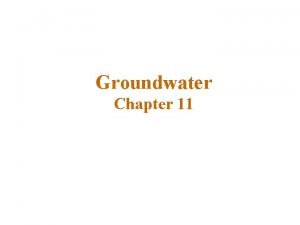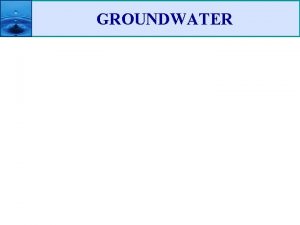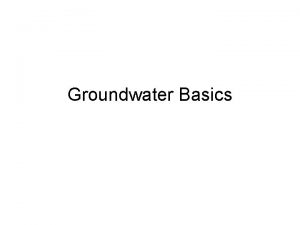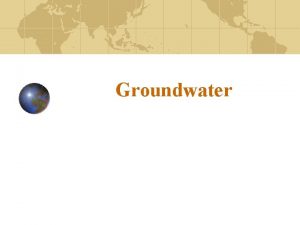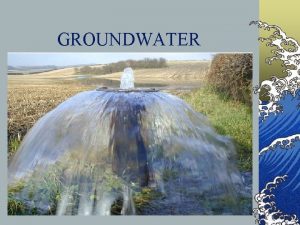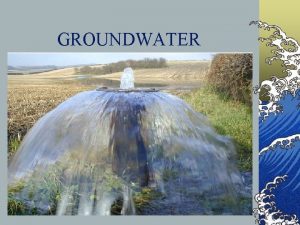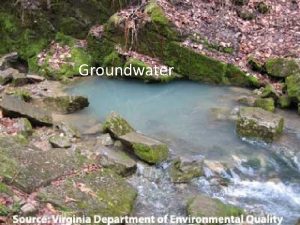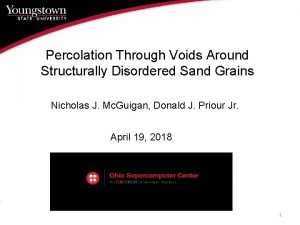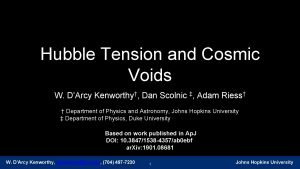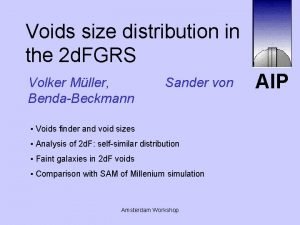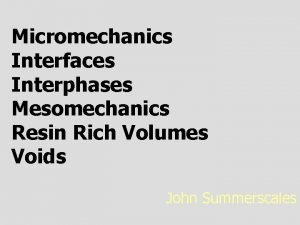Groundwater 1 Groundwater flows slowly through the voids



















- Slides: 19

Groundwater 1 Groundwater flows slowly through the voids between grains or the cracks in solid rock. Much of our knowledge depends on field and laboratory observations. Here, for example, is an experiment to measure head loss in an aquifer.

Darcy’s Law • Henri Darcy established empirically that the energy lost ∆h in water flowing through a permeable formation is proportional to the length of the sediment column ∆L. • The constant of proportionality K is called the hydraulic conductivity. The Darcy Velocity VD: VD = – K (∆h/∆L) and since Q = VD A ( where A = total area) Q = – KA (dh/d. L)

Darcy’s Experiment 1. Velocities small, V ~ 0, so: Piezometers before and after sand. Pipe is full, so flow rate is constant 2. Head difference doesn’t change with inclination of the sand filter 3. Again, Darcy related reduced flow rate to head loss and length of column through a constant of proportionality K, V = Q/A = -K dh / d. L 3

Darcy’s Data (One set of 10 experiments) 1. Darcy collected data with his apparatus, then … 4

Plotted it. Note the strong coefficient of determination R 2. 5

Darcy’s allows an estimate of: • The velocity or flow rate moving within the aquifer • The average time of travel from the head of the aquifer to a point located downstream • Very important for prediction of contaminant plume arrival Confined Aquifer

Darcy & Seepage Velocity • Darcy velocity VD is a fictitious velocity since it assumes that flow occurs across the entire cross-section of the sediment sample. Flow actually takes place only through interconnected pore channels (voids), at the seepage velocity VS. Av voids A = total area

Darcy & Seepage Velocities • From the Continuity Eqn. Q = constant • “Pipe running full” means “Inputs = Outputs” • Q = A VD = AV Vs – Where: Q = flow rate A = total cross-sectional area of material AV = area of voids Vs = seepage velocity VD = Darcy velocity Since A > AV , and Q = constant, Vs > VD Pinch hose, reduce area, water goes faster

Darcy & Seepage Velocity: Porosity • Q = A VD = AV Vs , therefore VS = VD ( A/AV) • Multiplying both sides by the length of the medium (L) divided by itself, L / L = 1 • VS = VD ( AL / AVL ) = VD ( Vol. T / Vol. V ) we get volumes • Where: Vol. T = total volume Vol. V = void volume • By definition, Volv / Vol. T = n, the sediment porosity So the actual velocity: VS = VD / n

Turbulence and Reynolds Number • The path a water molecule takes is called a streamline. In laminar flow, streamlines do not cross, and the viscous forces due to hydrogen bonds are important. • In turbulent flow acceleration and large scale motion away from a smooth path is important (this is the familiar inertial force F = ma) and streamlines cross. • We could take the ratio of inertial to viscous forces. When this number is “large, ” inertial forces are more important, and flows are turbulent. • This ratio is known as the Reynolds number Re:

Viscosity • Viscosity is a fluid’s resistance to flow. • Dynamic viscosity m, units Pa·s = N·s/m 2, or kg/(m·s) is determined experimentally. If a fluid with a viscosity of one Pa·s is placed between two plates, and one plate is pushed sideways with a shear stress of one Pascal, it moves a distance equal to the thickness of the layer between the plates in one second. • Kinematic viscosity n, is the dynamic viscosity divided by the density. The SI unit of ν is m 2/s.

Reynolds: Inertial/Viscous forces Recall the ratio of Kinetic/Potential Energy (KE/PE) is the Froude Number Fr Fr = V / sqrt( g L) we saw last time.

Limitations of Darcy’s Equation 1. For Reynold’s Number, Re, > 10 or where the flow is turbulent, as in the immediate vicinity of pumped wells. Darcy’s Law works for 1. 02. Where water flows through extremely fine-grained < Re < 10 Q = – KA (dh/d. L) q = – Ky (dh/d. L) materials (colloidal clay)

Example 1 Q = KA (dh/d. L) The hydraulic conductivity K is a velocity, length / time and n = Vol voids/ Vol total • A confined aquifer has a source of recharge. • K for the aquifer is 50 m/day, and porosity n is 0. 2. • The piezometric head in two wells 1000 m apart is 55 m and 50 m respectively, from a common datum. • The average thickness of the aquifer is 30 m, and the average width of the aquifer is 5 km = 5000 m. A piezometer is a small-diameter observation well used to measure the piezometric head of groundwater in aquifers. Piezometric head is measured as a water surface elevation, expressed in units of length.

Example 1 Compute: Q = KA (dh/d. L) • a) the rate of flow through the aquifer • (b) the average time of travel from the head of the aquifer to a point 4 km downstream

Example 1 Solution Q = KA (dh/d. L) • Cross-Sectional area= 30(5000) = 1. 5 x 105 m 2 • Hydraulic gradient dh/d. L= (55 -50)/1000 = 5 x 10 -3 • Find Rate of Flow for K = 50 m/day 5 2 Q = (50 m/day) (1. 5 x 10 m ) ( 5 x 10 -3) Q = 37, 500 m 3/day • Darcy Velocity: V = Q/A 5 2 3 • = (37, 500 m /day) / (1. 5 x 10 m ) = 0. 25 m/day

And • Seepage Velocity: Vs = VD/n = (0. 25) / (0. 2) = 1. 25 m/day (about 4. 1 ft/day) • Time to travel 4 km downstream: T = (4000 m) / (1. 25 m/day) = 3200 days or 8. 77 years • This example shows that water moves Lesson: Groundwater moves very slowly underground.

Example 2 • A channel runs almost parallel to a river, and they are 2000 ft apart. • The water level in the river is at an elevation of 120 ft. The channel is at an elevation of 110 ft. • A pervious formation averaging 30 ft thick and with hydraulic conductivity K of 0. 25 ft/hr joins them. • Determine the flow rate Q of seepage from the river to the channel. Confining Layer 30 ft Aquifer

Example 2: Confined Aquifer • Consider 1 -ft (i. e. unit) lengths of the river and small channel. Q = KA [(h 1 – h 2) / L] • Where: A = (30 x 1) = 30 ft 2 K = (0. 25 ft/hr) (24 hr/day) = 6 ft/day • Therefore, Q = [6 ft/day (30 ft 2) (120 – 110 ft)] / 2000 ft Q = 0. 9 ft 3/day for each 1 -foot length
 Octahedral voids in bcc
Octahedral voids in bcc Position of tetrahedral voids in hcp
Position of tetrahedral voids in hcp Institutional voids
Institutional voids Wsat24
Wsat24 Tetrahedral holes in fcc
Tetrahedral holes in fcc Flows of funds through the financial system
Flows of funds through the financial system Yamuna tributaries
Yamuna tributaries Through what countries does the mekong river flow
Through what countries does the mekong river flow Whats the thickest layer of the earth
Whats the thickest layer of the earth The tiger crept slowly behind the tree
The tiger crept slowly behind the tree Prototypes in semantics
Prototypes in semantics Rocky slowly got up from the mat
Rocky slowly got up from the mat The four candles
The four candles Culture definition
Culture definition Irregular adjectives and adverbs
Irregular adjectives and adverbs Cross timbers erosion
Cross timbers erosion The wheels of justice turn slowly figurative language
The wheels of justice turn slowly figurative language Map of heart of darkness
Map of heart of darkness Slowly by james reeves
Slowly by james reeves Infatuation v love
Infatuation v love
